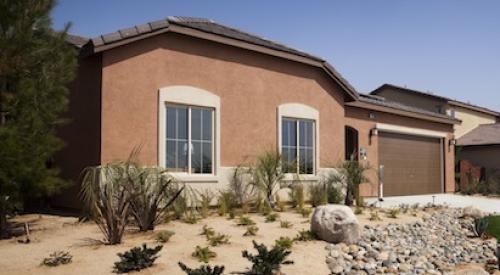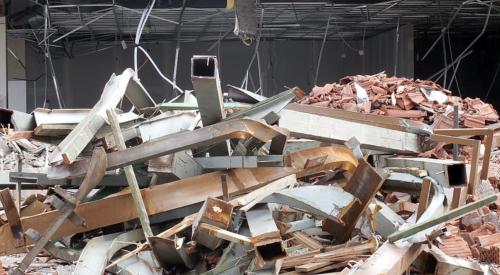|
|
|
The differences between an FPSF and a conventional foundation include cost and materials savings gained by a much shallower excavation and less time required. Horizontal insulation of FPSF is necessary only in very cold climates.
|
A frost-protected shallow foundation (FPSF) makes an elegant building solution from either side of the new home transaction. Homeowners benefit from increased comfort and lower energy bills. Builders profit from reduced excavation and materials costs, as well as shorter cycle time.
Recently named a PATH top-10 technology for 2004, an FPSF uses conventional, readily available materials. This foundation system is a practical option for building with slab-on-grade, stem-wall or floating slab foundations, as well as for an unvented (heated) crawl space and the on-grade side of a walk-out basement.
Despite their broad applicability, FPSFs are not used widely in the United States. Through its technology transfer efforts, PATH is working to accelerate the adoption of practical innovations such as FPSFs into mainstream building practices by identifying and tackling the barriers to market penetration.
What's Different About FPSFs?
Traditional, uninsulated foundations are protected from frost heave because they're installed below the frost line (up to 48 inches below the surface, depending on geographic region). FPSFs require excavation only 12 to 16 inches below grade because insulation is applied around the outside of the foundation to direct the building's heat loss downward. For heated buildings, this insulation - along with the earth's geothermal energy - keeps the soil temperature under the building above freezing, preventing frost heave.
More than 1 million FPSFs have been used in Scandinavia since 1960. For almost 30 years, Scandinavian building codes have recognized the use of FPSFs as a standard practice for houses, townhomes, apartments, stores, schools and low-rise office buildings. The NAHB and the NAHB Research Center began aggressively promoting FPSFs in the early 1990s. Since then, PATH has sponsored several field evaluations to discover more about the technology.
Research findings from field evaluations in Denver and Freehold Township, N.J., show that construction and excavation requirements, as well as labor and materials costs, are 15% to 17% less for an FPSF than for a conventional foundation. The savings range - $800 to $6,000 - reflects varying local frost depths, as well as builder overhead and markups.
Because an FPSF is insulated along the outside edges, it makes floors at the perimeter of the home significantly warmer. It also reduces heat loss through the foundation. A 1999 study prepared for the Kansas Corporation Commission's Energy Program by Joseph King, AIA, of Coriolis Architecture in Lawrence, Kan., and Gene Meyer, P.E., of Kansas State University showed that slab insulation could reduce homeowner energy bills by $50 to $100 per year, depending on the region and type of heating system.
|
The insulation has been placed but not secured. Once it is, this FPSF will be ready to accept a post-tensioned slab.
|
|
The insulation receives a durable exterior coating, usually stucco or synthetic stucco, to protect it.
|
Factors to Consider
An FPSF is most effective in areas where frost heave is an issue. Builders in Colorado, Iowa, Minnesota, Missouri, New Hampshire, New Jersey, New York, North Dakota and Washington have been enthusiastic about the results.
Builders interested in using FPSFs first need to determine their area's air freezing index (AFI), a measure of the magnitude and duration of winter air temperatures. The AFI is used to design foundations and insulation for specific locations. Builders also must obtain the mean annual temperature (MAT) if the FPSF will be used in an unheated building (see "Learn More" to find additional information on the AFI and MAT).
The American Society of Civil Engineers' standard "Design and Construction of Frost-Protected Shallow Foundations" (ASCE/SEI 32-01) addresses FPSF design and construction in areas subject to ground freezing. Although the 2000 International Residential Code adopted the standard and the 2003 IRC included it, local codes still govern FPSF use.
FPSFs might be inappropriate in warmer, more humid climates, where builders would save relatively little and termites can be a problem. Those pests could find a hidden path to the framing through foam insulation used on exte-rior foundation walls. Builders must be familiar with termite protection methods in their area and need to check with local code authorities to determine related requirements.
Gaining Market Acceptance
The prospect of much greater market acceptance of FPSFs is especially promising because, unlike many new technologies, this foundation system offers builders immediate cost savings. FPSFs cost less than traditional foundations in construction and excavation requirements, as well as labor and materials costs. Because they require shallower excavations and less concrete, FPSFs also save time. And because this system gives homeowners recurring utility savings, FPSFs offer builders an edge in competitive markets.
So if FPSFs are so great, why aren't they better known? No one in the industry actively promotes FPSFs, so industry awareness - and therefore market acceptance - are low, and local officials unfamiliar with the technology might be unwilling or unable to approve it promptly.
To increase awareness of FPSF technology, PATH disseminates architectural details and specifications to designers and architects, provides demonstrations and workshops, writes articles, and develops case studies and cost comparisons. Future initiatives will include ensuring that local code officials are aware of FPSFs in the model codes and providing information and training to local inspectors on how to apply the codes. n
PATH is seeking partners to promote FPSFs. Contact Bob Fuller at the NAHB Research Center, 800/638-8556, extension 6216, or bfuller@nahbrc.org.
- The NAHB Research Center provides information and answers frequently asked questions on the use of frost-protected shallow foundations at www.toolbase.org/fpsf. The Web page addresses FPSF standards, the air freezing index (AFI) and mean annual temperature (MAT), radiant floor heating with FPSFs, International Residential Code requirements for constructing an unheated garage connected to a home built on an FPSF, and methods for insulating additions built on an FPSF. The FAQs page suggests ways to work with building officials hesitant to approve FPSF installation.
- The NAHB Research Center’s Design Guide for Frost-Protected Shallow Foundations (2004) helps determine proper foundation design and insulation details. This guide contains detailed drawings for the prescribed construction methods. In addition, the NAHB has published brochures that describe the various uses of this technology.
- For more information on FPSF technologies, e-mail the ToolBase technical staff at toolbase@nahbrc.org or call 800/898-2842.
- To order a copy of the ASCE/SEI 32-01 "Design and Construction of Frost-Protected Shallow Foundations," visit asce.org.
- Order or download the 1994 PATH publication Design Guide for Frost-Protected Shallow Foundations through www.huduser.org.
- For more information on PATH’s technology transfer efforts and its top-10 technologies for 2004, visit pathnet.org.










